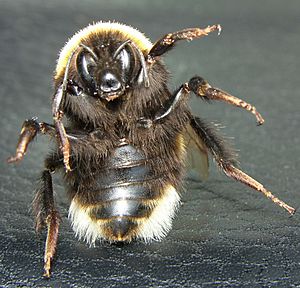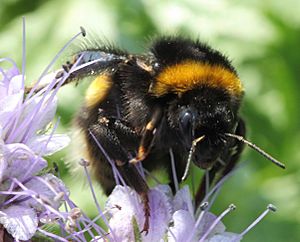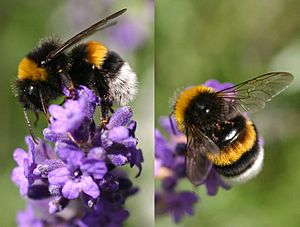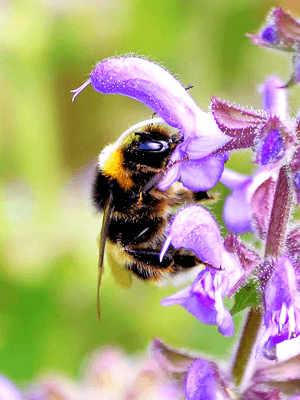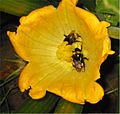Buff-tailed bumblebee facts for kids
Quick facts for kids Buff-tailed bumblebee |
|
|---|---|
 |
|
| Scientific classification | |
| Genus: |
Bombus
|
| Species: |
terrestris
|
| Synonyms | |
|
|
The buff-tailed bumblebee, also known as Bombus terrestris, is a very common bumblebee found in Europe. It's one of the main types of bees used to pollinate crops in greenhouses. Because of this, you can now find it in many places where it didn't originally live, like Tasmania.
This bumblebee is a social insect. This means they live in organized groups with different jobs for each bee. They also take care of their young together. The queen bee mates with only one male. Buff-tailed bumblebee workers are good at learning flower colors. This helps them find food efficiently.
Contents
- What is the Buff-Tailed Bumblebee?
- How to Identify a Buff-Tailed Bumblebee
- Where Do Buff-Tailed Bumblebees Live?
- How a Bumblebee Colony Works
- How Buff-Tailed Bumblebees Mate
- Learning and Social Behavior
- Bee Health and Threats
- Environmental Concerns
- Why Buff-Tailed Bumblebees Are Important to Humans
- Images for kids
- See also
What is the Buff-Tailed Bumblebee?
The buff-tailed bumblebee belongs to the insect group called Hymenoptera. This group includes ants, bees, and wasps. Specifically, it is part of the Apidae family, which is made up of bees. Within this family, it's in the bumblebee tribe, called Bombini.
It belongs to the genus Bombus, which includes all bumblebees. There are several closely related species, like the white-tailed bumblebee (Bombus lucorum). Scientists recognize nine different types, or subspecies, of Bombus terrestris. Each subspecies has its own special colors.
How to Identify a Buff-Tailed Bumblebee
Buff-tailed bumblebees collect nectar and pollen for food. The queen bee is usually the largest, about 20 to 22 millimeters long. Male bees are smaller, around 14 to 16 millimeters. Worker bees are 11 to 17 millimeters long.
Workers have white tips on their abdomens. They look a lot like the white-tailed bumblebee (B. lucorum). The main difference is that the buff-tailed bumblebee has darker yellowish bands. The queen of B. terrestris has a special buff-white tip on her abdomen. This is how she gets her name, "buff-tailed."
These bees are unique because their workers come in many different sizes. Their bodies can range from 2.3 to 6.9 millimeters long. Their weight can be from 68 to 754 milligrams.
Where Do Buff-Tailed Bumblebees Live?
Buff-tailed bumblebees are most common in Europe. They usually live in places with mild weather. You can also find them in the Near East, on islands in the Mediterranean Sea, and in North Africa.
These bees have been brought to other countries to help pollinate plants in greenhouses. Sometimes, they escape and start living in the wild. This has made them an invasive species in places like Japan, Chile, Argentina, and Tasmania.
Their nests are usually found underground. They often use old dens made by rodents. The bees build comb-like structures for their eggs. The queen lays eggs on top of each other. A typical colony has about 300 to 400 bees, but this number can vary a lot.
How a Bumblebee Colony Works
Like most social bees, buff-tailed bumblebees have three main groups, or castes. Each group has different jobs to help the colony run smoothly.
Bee Roles in the Colony
- Queens: There is only one queen per colony. Her main job is to lay eggs. Larvae that get more food and grow longer often become future queens.
- Workers: These are all female bees. They mainly search for food, protect the nest, and care for the growing larvae. Workers are usually unable to have their own young for most of the colony's life.
- Drones: These are male bees. They hatch from unfertilized eggs. Drones leave the nest when they are grown. Their only job is to find a mate outside the colony.
The Life Cycle of a Colony
A new colony starts when a single queen, who hatched from an old colony, mates with a male. She then finds a nest site. She stays in this nest over winter. In the spring, she lays a small group of female eggs.
Once the eggs hatch, the queen feeds the larvae with nectar and pollen. When the larvae are big enough, they turn into pupae. About two weeks later, the first worker bees emerge. This is the start of the colony.
Workers then collect food for the colony and care for new larvae. Workers are smaller than the queen. They often die while looking for food, sometimes eaten by predators like birds. Workers usually search for food within a few hundred meters of their nest.
Later in the colony's life, the queen starts laying some unfertilized eggs. These eggs grow into male drones. When the drones leave the nest, they do not come back. They look for new queens to mate with. The remaining female eggs get extra food and grow into new queens.
The queen uses special chemicals called pheromones to stop workers from raising too many new queens. This can cause a conflict between the queen and the workers. The colony usually lasts until fall in places with cold winters. Then, workers may start laying their own unfertilized eggs, which also become males. At this point, fighting can start among the workers and between the queen and workers.
Eventually, the old colony dies out. The newly emerged queens sometimes help raise one more group of bees. They also leave the nest daily to find food and may mate. Then, they find a safe place to hibernate until the next spring. In warmer places, they might not hibernate. Often, a new queen will return to the old nest site if it is free of parasites.
How Buff-Tailed Bumblebees Mate
Buff-tailed bumblebees usually mate with only one male. Mating with many males could make the offspring more genetically diverse. But this is rare in bumblebees. Male buff-tailed bumblebees put a sticky substance into the female's reproductive tract during mating. This seems to stop the female from mating with other males for several days.
Finding many mates can be risky for the queen. It uses a lot of energy and makes her more likely to be caught by predators. Also, worker bees are more closely related to their full sisters than to their half-sisters. This is because of how their genes are passed down. So, workers prefer to help raise full sisters.
Worker Bees Laying Eggs
Besides the queen, worker bees can also lay eggs. Since workers do not mate, all their eggs are unfertilized and will become male drones. Several things decide if a worker bee will lay eggs.
Workers born early in the colony's life are more likely to lay eggs. This is because they are larger and older. They also have more time for their ovaries to develop. Workers usually need to be at least 30 days old to lay eggs. Workers who spend less time looking for food and more time near the queen are also more likely to reproduce.
When workers compete to lay eggs, older workers often bother the queen. They might attack her or buzz loudly. Once this happens, the colony is usually abandoned.
How Many Males and Females?
The number of male and female bees in a colony can vary. This depends on when the queen starts producing males. Colonies that start producing males early have many more males than future queens. Colonies that start later have fewer males and a more even number of males and females. This shows the queen's control over her colony.
Workers prefer to have more males because they are more related to their own sons. The queen prefers an equal number of males and females. This is because she is equally related to both her sons and daughters.
Learning and Social Behavior
New worker bees start at the bottom of the colony's social ladder. As they get older, they move closer to the queen's position. Workers who stay near the queen often lay eggs. They also interact more with the queen. This social position can be helpful later. When workers overthrow the queen, the most dominant worker might lay more eggs. She might even become a "false queen."
Finding Food
Buff-tailed bumblebees look for food on many different types of flowers. They are most active in the morning, usually peaking around 7-8 AM. This is likely because it gets warmer in the afternoon. Foragers prefer temperatures around 25°C when collecting nectar and pollen.
Different Jobs for Different Sizes
Buff-tailed bumblebees show something called alloethism. This means bees of different sizes do different jobs. This is often seen in how they find food. Larger bees are more likely to forage outside the nest. They also bring back more nectar and pollen.
Larger bees might be better at handling different temperatures. They might also avoid predators better and travel longer distances. This could be good for the colony. Smaller bees are cheaper to raise. They can stay inside the nest for tasks there. Only some larvae get enough food to become large foraging bees.
Food Alerts
When bees return to the nest after finding food, they often tell other bees to go out and search. In buff-tailed bumblebees, successful foragers run around wildly in the nest. This is different from the special dance honeybees do. Scientists think this running spreads a special smell, or pheromone. This smell tells other bees where food is and encourages them to go forage.
Colonies that don't have much food respond more to this pheromone. Colonies with plenty of food respond less. This saves them time and energy from unnecessary foraging.
Finding Their Way Home
Buff-tailed bumblebees are very good at finding their way home. Bees moved far from their nests can find their way back from up to 9.8 kilometers away. However, it can take several days to return. This suggests they use familiar plants and landmarks to find the nest.
Another study showed they can navigate back from as far as 13 kilometers. But most bees forage within 5 kilometers of their nest. One study found their average foraging distance was about 663 meters. Male bees can fly even farther than worker bees. This is probably because they travel farther to find mates. Males can fly anywhere from 2.6 to 9.9 kilometers.
How Bees Learn
Bumblebees and honeybees naturally prefer blue and yellow colors. If they haven't been trained, they usually visit flowers that naturally attract them. However, bees learn to visit flowers that give them more nectar. They connect the reward with the flower's color.
This has been shown in buff-tailed bumblebees. Bees trained on artificial flowers of a certain color will choose similar colors later. If tested with very different colors, they go back to their natural color preferences. Young worker bees also need to learn complex skills to collect nectar and pollen efficiently. These skills can take several days to develop.
Learning from Others
Even though bees often forage alone, young foragers can learn faster when they are with older workers. Buff-tailed bumblebees learn more quickly to visit new, rewarding flowers if they see another bee foraging on the same type of flower. This type of learning, where they learn by watching others, is a new discovery in bee behavior. It can help them learn in addition to learning by color and reward.
Bee Health and Threats
Parasites and Diseases
Buff-tailed bumblebees can be affected by different parasites.
- Brood Parasites: Some cuckoo bees, like Bombus bohemicus and B. vestalis, invade B. terrestris nests. They take over from the queen and lay their own eggs. The host workers then care for these foreign eggs. B. vestalis only targets B. terrestris.
- Microsporidian Parasites: Nosema bombi is a common parasite that infects the gut of bumblebees. It can make bees sick and harm their health.
- Deformed Wing Virus (DWV): This virus usually affects honey bees, causing their wings to be small and crumpled. It is thought to have spread to B. terrestris. In 2004, some commercially bred queen bees were found dead with deformed wings due to this virus. This shows that DWV might affect many types of bees.
Bee Moths
Female Bee Moths (Aphomia sociella) like to lay their eggs in bumblebee nests. When the moth larvae hatch, they eat the eggs, larvae, and pupae of the bees. They can cause a lot of damage to the nest as they tunnel through it looking for food.
Environmental Concerns
Invasive Species
While native to Europe, B. terrestris has been brought to many other places as a greenhouse pollinator. Now, its presence is a concern in many of these new areas. It is called an "invasive alien species" in Japan. For example, in Japan, B. terrestris competes with local Japanese bee species for flowers and nest sites. They are displacing native queens from underground nest sites.
In 2008, Australia banned the import of live B. terrestris. This was because they feared it would become a wild species and harm native plants and animals. In Chile, B. terrestris was introduced in 1998. It has since spread into Argentina, moving about 275 kilometers each year. Its spread has been very bad for Bombus dahlbomii, the only bumblebee native to southern South America. This is due to competition and the spread of parasites like Apicystis bombi, which the buff-tailed bumblebees carry without being harmed.
Pesticide Exposure
Studies have shown that certain pesticides can harm bumblebees. In 2014, researchers used special tags on bees. They found that even small amounts of pesticides, like neonicotinoids or pyrethroids, made it harder for bumblebees to find food.
Research in 2015 also showed that bees actually prefer solutions with neonicotinoids. But eating these pesticides made them eat less food overall. This means that using these pesticides on flowering crops can be very dangerous for foraging bees.
Why Buff-Tailed Bumblebees Are Important to Humans
Commercial Use
Since 1987, B. terrestris has been raised commercially. It is used to pollinate greenhouse crops in Europe, especially tomatoes. Before this, people had to pollinate these crops by hand.
Buff-tailed bumblebees are now used in many countries, including New Zealand, North Africa, Japan, Korea, and Russia. More than 1 million bumblebee nests are traded globally each year. However, some countries, like Korea, prefer to use other bee species. This is to avoid competition or mixing genes with native bumblebees. North America has also banned importing B. terrestris. This has led to more interest in other species like B. impatiens.
B. terrestris are very important commercial pollinators in Europe. Scientists are studying how farms affect these bees. Farms with only one type of crop (monoculture) reduce the number of different flowers bees can visit. Because of this, B. terrestris nests grow better in suburban areas than on farmland. Suburban gardens often have more plant diversity for bees to feed from. Farming has a big impact on many bumblebees. It is causing many species to decline. However, B. terrestris is still widespread. This is likely because it can fly long distances to find food. This makes it less sensitive to changes in the environment.
Images for kids
See also
 In Spanish: Abejorro común para niños
In Spanish: Abejorro común para niños


